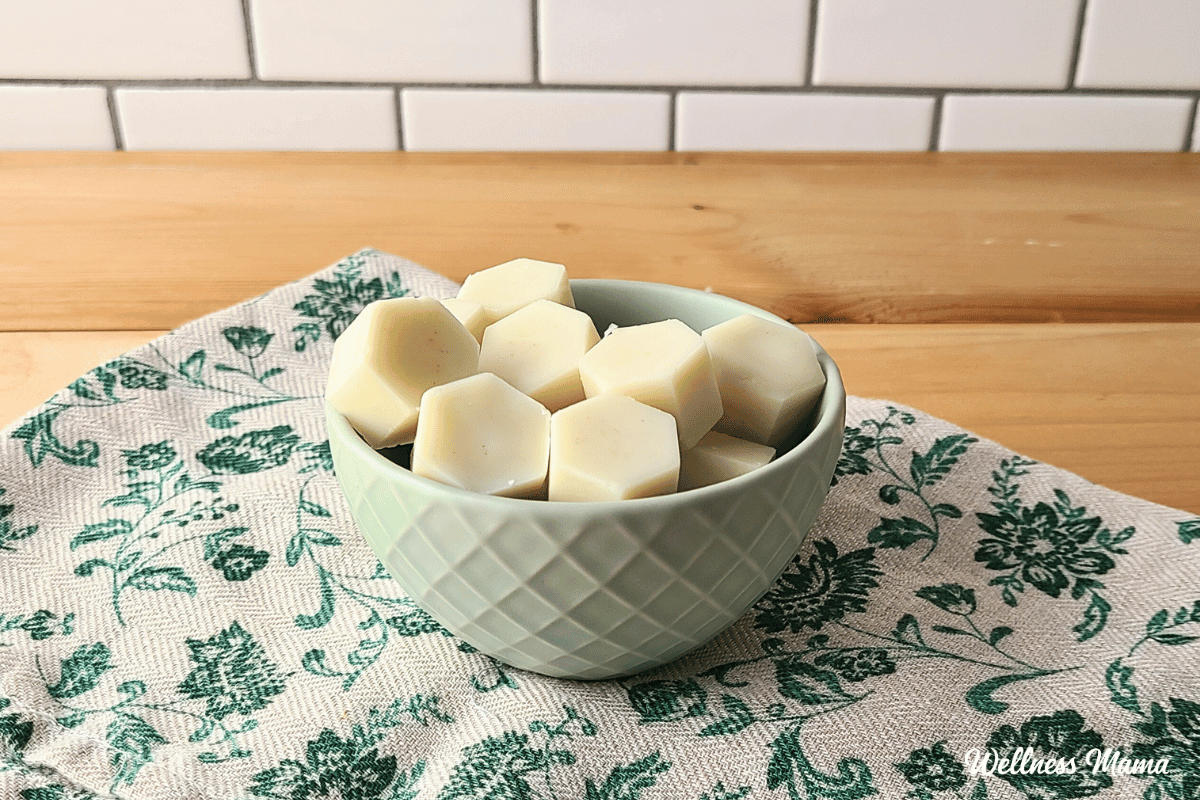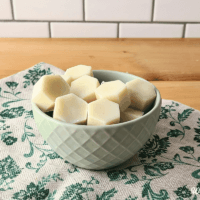Ahhh, the joys of taking a moment to relax and breathe in that new scented wax melt you just bought… Until you realize you’re breathing in synthetic fragrances, carcinogens, and something called Benzophenone-12. Wax melts can make a home feel inviting and promise scents like latte, watermelon, and cheesecake, but many are full of toxins.
Here’s how to make your own DIY wax melts for a cozy home fragrance without the harmful chemicals!
What Are Wax Melts?
You may have seen these in the candle aisle at your local big box store. Or sold at craft fairs and flea markets. People in the USA and around the world are obsessed with them. In 2023 the global market size for wax melts was valued at over 3.4 billion (yes, with a B). And that’s projected to increase by at least 6% every year.
Wax melts are similar to a candle except they don’t have a wick. The idea is they’re safer than having an open flame. You simply put a few wax melts in your melt warmer and your favorite scents create the perfect ambiance. If they’re full of unhealthy ingredients though, then they’re likely not much safer!
Ingredients to Die For
Wax melts come in many different colors and fragrances. While scents like sea salt, passionfruit, honeysuckle, and fruity cranberry may seem natural, they’re anything but. That’s not to mention most wax melt cubes and tarts are usually made with paraffin or soy wax.
Most companies don’t disclose their wax melt ingredients list. The ones I could find were definitely something I don’t want floating in my home’s air! Here’s what you’ll find in the Febreze brand, one of the few that disclose a full ingredients list:
Wax Blend, Fragrances, Synthetic Wax, Benzophenone-12, Octrizole, Pentaerythrityl Tetra-Di-T-Butyl Hydroxyhydrocinnamate, Phenol, 2.4-Bis(1.1-Dimethylethyl)-, 1.1′.1”-Phosphite, Colorants
If you’re looking for a healthy alternative, it’s easy to make your own!
DIY Wax Melts
Instead of a laundry list of synthetic chemicals, these wax melts use a few simple ingredients. Beeswax provides the base and has a light, honey scent. Coconut oil has a higher burn temperature than many oils and has a lower melting point than beeswax. The two together create a wax melt that melts like soy wax without the downsides.
I’ve also added essential oils for a subtle, inviting scent. These aren’t as strong as synthetic fragrance oils, but they also won’t give you a headache and neurological issues! Fragrance oils come in almost any scent known to man, from fireside to vanilla bean, to apple cider snickerdoodle. While the options are slightly more limited with essential oils, the trade-off is worth it!
Buy it: Already know you don’t want to make them? My favorite candle company sells beeswax melts made with pure essential oils you can get here. You can also get them here on Amazon.
Natural Scented Wax Melts
There are so many different essential oil options now. You can use a single oil, like pure lavender, or mix them to create your own blend. One of my favorite essential oil businesses, Plant Therapy, has a lot of yummy smelling premade blends. Essential oils also offer antimicrobial properties to help cleanse the air. Many, like citrus oils, also affect the limbic system to support a positive mood.
Here are a few ideas for what to use in your wax melts:
- Balsam Fir – Helps with coughs and supports the respiratory system. Helps purify the air and smells like a Christmas tree.
- Sandalwood – Has an earthy, warm scent that helps relax and calm tension. I love using it in this sandalwood tanning oil. It is more expensive but still works well when blended with cheaper oils like lavender, sweet orange, or patchouli.
- Citrus oils – Grapefruit, sweet orange, lemon, and lime are favorite scents. These “top notes” don’t linger in the air as long and can work better when blended with base notes. Examples include cedarwood, frankincense, and vetiver.
- Eucalyptus – Helps support healthy breathing and lung function. Blends well with a variety of oils, including peppermint, lavender, or geranium.
- Pumpkin spice – Make your own fall scented blend with cinnamon, clove, and cardamom essential oil. These oils have antimicrobial properties that are perfect for autumn colds and flu.
A Note on Safety
When essential oils are used in wax melts or candles they offer a subtle scent that won’t fill a large room. It’s still a good idea to keep safety in mind when burning them around children or pets though. Do your research and only use oils that are kid-friendly and/or pet-safe when burning them around these groups.
These KidSafe blends from Plant Therapy help take out the guesswork. And you can read about which essential oils are safe for pets here.
While wax melts don’t have an open candle flame, it’s still best to keep your melt warmer away from where pets and little ones can knock it over or burn themselves.
Colored Melts
Beeswax has a yellow, honey-colored hue that I love in candles. If you want a different color though, then there are a few natural colorant options. One is indigo for a deep, blue hue. I haven’t tried it personally so I’m not sure if it will stain a wax warmer tray.
Another option is alkanet root. When it’s infused in oil, alkanet yields a rich, ruby red color. It’s often used in natural tinted lip balms.
Homemade Wax Melts
Materials
- ¼ cup refined coconut oil (or avocado oil)
- ½ cup beeswax pellets
- 40 drops essential oils of choice
Instructions
- Add the oil and beeswax to a double boiler or glass bowl. Heat over medium-high heat until completely melted, stirring occasionally.
- Once melted, turn off the heat and stir in the essential oils.
- Pour into silicone molds of choice and let cool completely.
Notes
Where to Get a Wax Warmer
Wax warmers burn at about 150 to 200 degrees Fahrenheit. You can also use a double boiler on the stove with your wax melts. The downside to this though is that the scent is relegated to your kitchen area.
There are lots of different wax warmers, but the electric ones (not the tea light ones) work better. Many wax warmers are ceramic which likely have lead in the glaze. There are some glass options that don’t have this issue. You can also get a glass dish to set on your wax warmer.
If you like this tutorial check out how to make your own beeswax candles here.
Which scents are your favorite for candles and wax melts? Leave a comment and let us know!





Leave a Reply